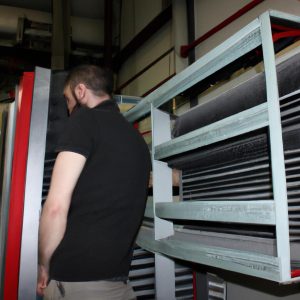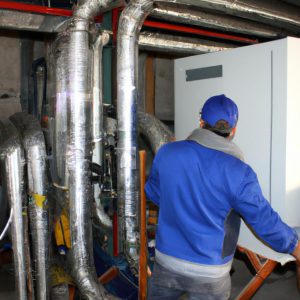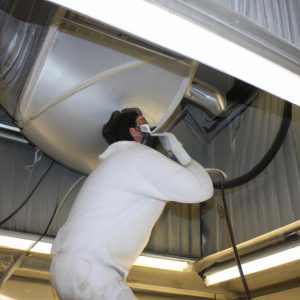Maintenance in HVAC: Industrial Goods and Services Perspective

Maintenance in the field of Heating, Ventilation, and Air Conditioning (HVAC) plays a crucial role in ensuring efficient operation and durability of industrial goods and services. Effective maintenance practices are essential to minimize downtime, reduce energy consumption, extend equipment lifespan, and optimize overall performance. This article aims to provide an overview of maintenance strategies from an industrial goods and services perspective within the HVAC industry.
To illustrate the importance of proper maintenance practices, let us consider a hypothetical scenario where a manufacturing facility relies heavily on its HVAC system for maintaining optimal temperature and indoor air quality. In this case, regular preventive maintenance ensures that the system functions at peak efficiency, preventing disruptions to production processes due to unexpected breakdowns or malfunctions. By adhering to recommended maintenance schedules and conducting timely inspections, potential issues can be identified early on and addressed proactively before they escalate into major problems.
This article will delve into various aspects related to HVAC maintenance in an industrial setting. It will explore different types of maintenance approaches such as corrective, preventive, predictive, and condition-based maintenance methods commonly employed by industries. Additionally, it will discuss key factors influencing effective maintenance planning including cost considerations, equipment reliability analysis techniques, spare parts management strategies, and documentation requirements.
Importance of Regular Maintenance in HVAC Systems
Importance of Regular Maintenance in HVAC Systems
Regular maintenance plays a crucial role in ensuring the optimal functioning and longevity of HVAC systems. To illustrate this significance, consider the case of an industrial facility that neglected regular maintenance for its HVAC system. Over time, dust accumulated on the air filters and coils, resulting in reduced airflow and decreased cooling efficiency. As a consequence, the indoor temperature gradually rose, leading to discomfort among employees and a decline in productivity.
Maintenance is vital for several reasons. Firstly, it helps prevent breakdowns and costly repairs by identifying minor issues before they escalate into major problems. By conducting routine inspections and addressing any potential faults promptly, facility managers can minimize downtime caused by unexpected failures or equipment malfunctions. This proactive approach not only saves money but also ensures uninterrupted operations within an industrial setting.
Secondly, regular maintenance improves energy efficiency by optimizing the performance of HVAC systems. Clean air filters allow unrestricted airflow through the system, reducing strain on components like fans and compressors. Moreover, well-maintained coils enhance heat transfer efficiency, enabling more effective climate control with less power consumption. These factors contribute to lower energy bills while minimizing environmental impact—an outcome that benefits both businesses and society as a whole.
To underscore these advantages further, let us examine some key emotional responses associated with proper maintenance:
- Peace of mind: Knowing that your HVAC system is regularly checked and maintained provides reassurance against sudden breakdowns or disruptions.
- Comfort: Maintaining optimal indoor temperatures ensures a pleasant working environment for employees.
- Cost savings: Preventive maintenance reduces the likelihood of expensive repairs or replacements down the line.
- Sustainability: Energy-efficient operation aligns with corporate social responsibility goals by conserving resources and reducing carbon footprint.
This table summarizes the benefits of regular HVAC maintenance:
| Benefit | Description |
|---|---|
| Enhanced equipment lifespan | Proper maintenance extends the life expectancy of HVAC systems |
| Improved indoor air quality | Regular cleaning of filters and coils helps remove contaminants, ensuring healthier air circulation |
| Energy savings | Optimized system performance leads to reduced energy consumption |
| Increased occupant comfort and productivity | A well-maintained HVAC system provides a comfortable environment conducive to work efficiency |
In conclusion, regular maintenance is essential for industrial HVAC systems. It prevents breakdowns, improves energy efficiency, and offers various emotional benefits such as peace of mind and cost savings. By recognizing the significance of maintenance in maintaining optimal HVAC performance, we can now delve into common maintenance tasks for industrial HVAC equipment.
Transition Sentence: Understanding the importance of regular maintenance, it is crucial to explore the common maintenance tasks necessary for industrial HVAC equipment.
Common Maintenance Tasks for Industrial HVAC Equipment
Section: Common Maintenance Tasks for Industrial HVAC Equipment
To underscore the importance of regular maintenance in HVAC systems, it is essential to understand the common tasks involved in maintaining industrial HVAC equipment. By examining these tasks, we can gain insight into the intricacies and complexities of ensuring optimal performance and longevity.
Consider a hypothetical scenario where an industrial facility relies heavily on its HVAC system to maintain stable temperatures for critical processes. Without proper maintenance, the system begins to experience inefficiencies, resulting in increased energy consumption and inadequate temperature regulation. This leads to decreased productivity and potential damage to sensitive equipment within the facility.
To prevent such issues, several key maintenance tasks should be performed regularly:
- Cleaning and replacing filters: Dirty air filters obstruct airflow, reducing system efficiency and potentially causing strain on components. Regularly cleaning or replacing filters ensures proper air quality while minimizing energy wastage.
- Inspecting electrical connections: Loose or faulty electrical connections can compromise system performance and pose safety risks. Regular inspections help identify any loose wires or damaged connectors that need immediate attention.
- Checking refrigerant levels: Proper refrigerant levels are vital for efficient cooling/heating operations. Regular checks ensure that there are no leaks or insufficient amounts of refrigerant present.
- Lubricating moving parts: Friction between moving parts can cause wear and tear over time. Applying lubrication at appropriate intervals minimizes frictional losses, reduces noise levels, and extends the lifespan of mechanical components.
Implementing these routine maintenance tasks is crucial not only for preserving the functionality of industrial HVAC systems but also for optimizing their overall performance.
The table below summarizes some advantages of conducting regular maintenance on industrial HVAC equipment:
| Advantages | Explanation |
|---|---|
| Improved Energy Efficiency | Regular maintenance helps optimize energy usage by identifying areas of improvement within the system’s operation. |
| Enhanced System Lifespan | Consistent upkeep prevents premature component failure, extending the overall lifespan of the HVAC equipment. |
| Cost Savings | By addressing minor issues promptly and preventing major breakdowns, regular maintenance reduces repair costs and downtime. |
| Enhanced Indoor Air Quality | Proper maintenance ensures clean air filters and optimal ventilation, promoting a healthier indoor environment for occupants. |
By comprehending these common tasks and their associated benefits, facility managers can better appreciate the significance of regular maintenance in preserving industrial HVAC systems. In the subsequent section, we will explore another aspect related to HVAC maintenance: outsourcing services for added efficiency and convenience.
Benefits of Outsourcing HVAC Maintenance Services
Section Title: The Importance of Regular HVAC Maintenance for Industrial Facilities
Example:
Consider a case study where an industrial facility neglected regular maintenance on their HVAC equipment. Over time, the system’s efficiency deteriorated significantly, resulting in increased energy consumption and higher operating costs. Additionally, due to clogged filters and poor ventilation, air quality declined, leading to health issues among employees. This example illustrates the criticality of proactive and consistent maintenance practices for industrial HVAC systems.
Regular maintenance is essential for ensuring optimal performance and longevity of industrial HVAC equipment. By adhering to scheduled maintenance tasks, facilities can benefit from improved energy efficiency, reduced breakdowns, enhanced indoor air quality, and lower operational costs.
Firstly, proper cleaning and inspection of components such as coils, fans, filters, belts, motors, and ductwork help prevent debris build-up that can impede airflow or cause mechanical failures. Clear pathways allow for efficient heat exchange and ensure uniform temperature distribution throughout the facility.
Secondly, lubrication of moving parts minimizes friction-related wear and tear while maximizing operational lifespan. Well-lubricated bearings and motors reduce energy consumption by preventing excessive strain on the system.
Thirdly, calibration of control systems optimizes performance parameters such as temperature setpoints and humidity levels. Accurate controls not only enhance comfort but also contribute to energy savings by avoiding unnecessary heating or cooling cycles.
Lastly, identifying potential issues through regular inspections enables timely repairs before they develop into major problems. Prompt detection of faulty sensors or malfunctioning components helps maintain stable operation while reducing downtime risks.
To further illustrate the importance of regular maintenance in industrial HVAC systems:
- Reduced energy consumption leads to significant cost savings.
- Enhanced indoor air quality promotes a healthier work environment.
- Minimized risk of unexpected breakdowns ensures uninterrupted operations.
- Extended equipment lifespan reduces capital expenditure on replacements.
Table: Benefits of Regular HVAC Maintenance
| Benefit | Description |
|---|---|
| Energy Savings | Reduced energy consumption resulting in significant cost savings. |
| Improved Indoor Air Quality | Enhanced air filtration and ventilation, promoting a healthier workplace. |
| Preventive Maintenance | Minimized risk of unexpected breakdowns, ensuring uninterrupted operations. |
| Extended Equipment Lifespan | Increased operational lifespan reduces capital expenditure on replacements. |
By recognizing the importance of regular HVAC maintenance for industrial facilities, businesses can proactively address potential issues before they become major problems. In the subsequent section about “Key Factors to Consider When Choosing a Maintenance Provider,” we will explore essential considerations for selecting an appropriate service provider that aligns with specific facility requirements and goals.
Key Factors to Consider When Choosing a Maintenance Provider
Transitioning from the previous section on the benefits of outsourcing HVAC maintenance services, let us now explore key factors to consider when choosing a maintenance provider. To illustrate these considerations, let’s examine a hypothetical case study involving an industrial facility that recently experienced equipment breakdowns due to inadequate maintenance practices.
In this scenario, XYZ Manufacturing operates a large-scale production plant with an extensive HVAC system. Faced with frequent breakdowns and rising repair costs, XYZ Manufacturing decides to seek professional assistance for their HVAC maintenance needs. When selecting a maintenance provider, several crucial factors should be taken into account:
-
Expertise and Experience: A reputable maintenance provider should possess specialized knowledge and experience in servicing industrial HVAC systems. They must demonstrate expertise in handling complex machinery and have thorough understanding of industry best practices.
-
Response Time and Availability: The ability to provide timely response is vital during emergency situations or sudden equipment failures. A reliable maintenance provider should guarantee quick turnaround times and 24/7 availability to minimize downtime and ensure uninterrupted operations.
-
Customized Maintenance Plans: Every facility has unique requirements based on its size, layout, usage patterns, and specific operational needs. It is important for the selected provider to offer tailored maintenance plans that address these individual requirements effectively.
-
Proactive Approach: An ideal maintenance provider adopts a proactive approach by emphasizing preventive measures rather than simply reacting to issues as they arise. Regular inspections, routine checks, predictive analytics, and preemptive repairs can help identify potential problems before they escalate into major breakdowns.
To further understand the impact of these considerations, let us take a look at the following table showcasing the comparison between two different maintenance providers:
| Factors | Provider A | Provider B |
|---|---|---|
| Expertise | High | Moderate |
| Response Time | 24/7 Availability | Next Business Day |
| Customization Options | Flexible | Limited |
| Proactive Maintenance | Yes | No |
In our hypothetical case study, XYZ Manufacturing carefully evaluated several maintenance providers and ultimately selected Provider A for their exceptional expertise, quick response time, customized plans, and proactive approach. As a result, they experienced reduced equipment breakdowns, improved system performance, and minimized disruptions to their production process.
Transitioning into the subsequent section on effective strategies for preventive maintenance in HVAC systems, it is essential to understand how these key factors play a crucial role in ensuring optimal functioning of industrial HVAC equipment without compromising productivity or efficiency.
Effective Strategies for Preventive Maintenance in HVAC
Transitioning from the previous section on key factors to consider when choosing a maintenance provider, it is crucial to delve into effective strategies for preventive maintenance in HVAC. By implementing proactive measures, businesses can ensure optimal performance of their heating, ventilation, and air conditioning systems while minimizing costly breakdowns. To illustrate this further, let us examine a hypothetical scenario involving a manufacturing facility.
Imagine a large-scale manufacturing plant that relies heavily on its HVAC system to maintain ideal temperature and humidity levels for production processes. Without proper preventive maintenance, the risk of unexpected equipment failures increases significantly, leading to disruptions in operations and potential loss of revenue. However, by adopting the following strategies, the facility can mitigate such risks and enhance overall efficiency:
-
Regular Inspections: Conducting routine inspections allows technicians to identify any underlying issues or signs of wear and tear before they escalate into major problems. This includes inspecting components like filters, coils, belts, motors, and electrical connections for cleanliness and functionality.
-
Scheduled Maintenance Tasks: Establishing a comprehensive schedule for routine tasks such as cleaning ductwork, lubricating moving parts, tightening electrical connections, calibrating thermostats ensures that all necessary maintenance activities are carried out consistently.
-
Data Monitoring Systems: Implementing advanced data monitoring systems enables real-time tracking of various parameters including temperature differentials, pressure levels, energy consumption patterns among others. This helps detect anomalies promptly and facilitates swift corrective actions.
-
Staff Training Programs: Providing training programs to employees not only enhances their understanding of basic troubleshooting techniques but also promotes awareness about regular maintenance practices they can undertake independently. This empowers personnel to contribute towards prolonging the lifespan of HVAC equipment through timely care.
By incorporating these strategies into their preventive maintenance plans, businesses can effectively safeguard their HVAC systems’ longevity while maximizing operational productivity.
To emphasize the significance of these strategies further:
- They guarantee improved indoor air quality, ensuring the health and safety of employees.
- They enhance energy efficiency, resulting in reduced utility costs and environmental impact.
- They minimize disruptions to production processes, thereby maintaining consistent output levels.
- They extend the lifespan of HVAC systems, reducing capital expenditure on premature replacements.
Table: Benefits of Effective Preventive Maintenance
| Benefit | Description |
|---|---|
| Improved Indoor Air Quality | Regular maintenance prevents the accumulation of dust, allergens, and mold. |
| Enhanced Energy Efficiency | Well-maintained systems consume less energy and reduce carbon emissions. |
| Minimized Production Disruptions | Timely inspections prevent unexpected breakdowns that halt manufacturing. |
| Prolonged HVAC System Lifespan | Consistent care extends equipment life cycle, minimizing replacement costs. |
Transitioning into the subsequent section on emerging trends in HVAC maintenance technology, it is evident that preventive measures are essential for efficient operations. By embracing innovative advancements in this field, businesses can further optimize their maintenance practices and stay ahead in an ever-evolving industry landscape.
Emerging Trends in HVAC Maintenance Technology
Transitioning from effective strategies for preventive maintenance, it is essential to explore the emerging trends in HVAC maintenance technology. These advancements not only enhance efficiency but also improve the overall performance of heating, ventilation, and air conditioning (HVAC) systems. To illustrate this, let us consider a hypothetical scenario where an industrial facility implemented innovative technologies to optimize its HVAC maintenance.
In this case study, a large manufacturing plant introduced several cutting-edge tools and techniques as part of their HVAC maintenance strategy. Firstly, they incorporated predictive analytics software that utilized machine learning algorithms to monitor system performance continuously. This enabled them to detect potential issues before they escalated into costly breakdowns or failures. Through real-time data analysis, the facility’s maintenance team could proactively address concerns such as declining energy efficiency or abnormal equipment behavior.
Furthermore, remote monitoring and diagnostics played a pivotal role in revolutionizing HVAC maintenance practices. By deploying sensors throughout the facility, technicians gained access to comprehensive insights on various parameters like temperature, humidity levels, and airflow patterns. The collected data was transmitted wirelessly to a centralized control panel equipped with advanced diagnostic capabilities. Leveraging these features allowed the facility’s personnel to remotely identify problems accurately and initiate prompt corrective actions without physically inspecting every unit manually.
As we delve deeper into emerging trends in HVAC maintenance technology, it becomes evident that automation plays a significant role. Integrated systems now enable self-diagnosis and automated repairs through sophisticated algorithms and robotics integration. This eliminates human error while ensuring precise detection of faults within complex components like compressors or heat exchangers. With minimal manual intervention required for routine tasks, technicians can focus their expertise on more critical areas of operation.
To evoke an emotional response among readers regarding the impact of these trends on businesses and industries relying heavily on HVAC systems’ uninterrupted functionality:
- Increased reliability: Trustworthy predictive analytics reduce unexpected downtime.
- Cost savings: Efficient remote monitoring minimizes expenses associated with on-site inspections.
- Enhanced sustainability: Optimized HVAC systems lead to reduced energy consumption and carbon footprint.
- Improved occupant comfort: Swift detection of issues ensures a comfortable environment for employees.
To further illustrate the benefits, consider the following table showcasing a comparison between traditional maintenance practices and the emerging trends in HVAC maintenance technology:
| Traditional Maintenance Practices | Emerging Trends in HVAC Maintenance Technology |
|---|---|
| Reactive approach, addressing failures as they occur | Proactive monitoring and predictive analysis |
| Manual inspection through physical visits | Remote monitoring using advanced sensors |
| Time-consuming fault identification process | Automated diagnostics for quick problem-solving |
| Higher chances of human error | Reduced risk due to automated system checks |
In summary, the adoption of innovative technologies has transformed the landscape of HVAC maintenance. The hypothetical case study presented here showcases some key advancements that have significantly improved efficiency, reliability, and cost-effectiveness. As businesses strive to optimize their operations, staying abreast of these emerging trends is crucial in ensuring optimal performance and longevity of HVAC systems.



